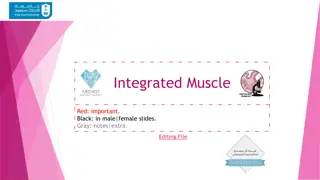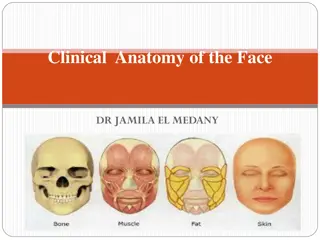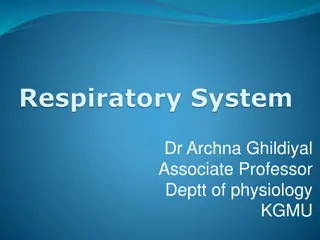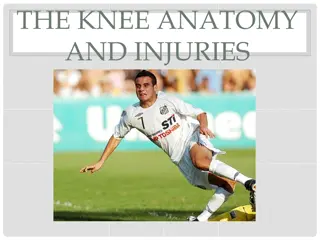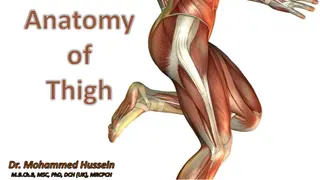The muscular system
The muscular system is a vital organ system that includes smooth, skeletal, and cardiac muscles. It plays a crucial role in locomotion, supporting the cardiovascular system, enabling lung ventilation, regulating fluids, maintaining posture, and generating heat in the body. This system consists of ar
2 views • 16 slides
Understanding Kinesiology Taping Techniques and Benefits
Kinesiology taping is a technique utilizing thin, flexible tape to relieve pain, reduce swelling, and provide support to muscles and joints. Introduced by Dr. Kenzo Kase in the 1970s, it includes techniques such as muscle, ligament, fascial, correction, lymphatic drainage, and functional movement te
8 views • 14 slides
Demonstration of Soft Parts of Lower Limb - Part 3 by Dr. Amber Rana at King George's Medical University
This presentation outlines the structures of the lateral compartment of the leg, posterior compartment of the leg, and dorsum of the foot. It includes information on boundaries, muscles, nerves, and vessels in each region, along with detailed descriptions of specific structures such as the peroneus
0 views • 15 slides
Animal Muscle Identification and Anatomy Diagrams
This collection includes detailed diagrams showcasing the identification and anatomy of muscles in animals, specifically focusing on pig muscle anatomy. From head and neck muscles to arm and shoulder muscles, pelvis and thigh muscles, and trunk muscles, these visual aids help understand the structur
3 views • 26 slides
Understanding Ice Hockey Face-Off Locations and Guidelines
Ice hockey face-offs must occur at specific locations marked on the ice, with rules governing where they take place based on various situations like rule infractions or stoppages. This guide covers the basic guidelines for determining face-off locations, including scenarios like intentional offside/
0 views • 12 slides
Demonstration of Lower Limb Soft Tissues - Part 3
This detailed demonstration by Dr. Amber Rana from King George's Medical University focuses on identifying and describing the structures of the lateral compartment of the leg, posterior compartment of the leg, and dorsum of the foot. It covers boundaries, muscles, nerves, and vessels present in each
0 views • 15 slides
Anatomy of Paravertebral Region and Root of Neck
This informative content presents the paravertebral region and the muscles of the neck, including the scalene muscles (posterior, medius, and anterior). It covers the origin, insertion, nerve supply, and actions of these muscles, providing a clear understanding of their functions. Additionally, it d
0 views • 18 slides
Understanding Pelvic Limb Anatomy: Bones and Muscles Overview
Bones and muscles of the pelvic limb, including the pelvis, thigh, leg, and foot, are detailed in this informative content. It covers the general designations of pelvic bones, descriptions of bones along with muscle attachments in various animals, and specifics about the hip bone structure and forma
1 views • 15 slides
Understanding the Intrinsic Muscles of the Tongue - Anatomy and Physiology Overview
In this detailed presentation by Dr. Sushma Tomar, Associate Professor of Anatomy, the intrinsic muscles of the tongue are explored, along with their functions, arterial and venous supply, lymphatic drainage, and nerve supply. The lecture covers the four intrinsic muscles in each half of the tongue,
1 views • 15 slides
Anatomy of the Prevertebral Region in the Neck
The prevertebral region in the neck extends from the 1st cervical vertebra to the upper two thoracic vertebrae. It includes structures like prevertebral and paravertebral muscles, cervical plexus, sympathetic chains, and large vessels. The prevertebral muscles, including rectus capitis anterior and
0 views • 15 slides
Understanding the Function of Muscles - Our Amazing Muscular System
Our muscles play a vital role in our bodies by helping us move, pump blood, digest food, and breathe. They are made up of muscle fibers and connected to bones by tendons. The muscles work by contracting and relaxing when we move. To keep our muscles healthy, it's important to engage in physical acti
0 views • 6 slides
Understanding the Histological Structure of Muscle Cells
This presentation delves into the histological structure of three types of muscle cells - skeletal, cardiac, and smooth muscles. Learn about their differences, such as striation, voluntary vs. involuntary control, and cellular organization. Discover the components of muscular tissue, the coverings o
0 views • 13 slides
Overview of Muscles of Mastication in Anatomy
This presentation by Dr. Sushma Tomar provides detailed information on the principal and accessory muscles of mastication, focusing on the Masseter and Temporalis muscles. It covers their origins, insertions, nerve supplies, actions, and applied aspects like trismus. The content is accompanied by im
0 views • 20 slides
Understanding the Biological Basis of Human Motion and Motor Learning
In the biological basis of human motion, a series of electro-chemical-physical reactions occur at the neuromuscular junction, enabling nerve stimulation for muscle contraction. Nerve impulses for movement originate in the central nervous system or muscles, with acetylcholine transmitting impulses be
0 views • 13 slides
Identifying Tender, Intermediate, and Tough Muscles in Various Steaks
Explore the classification of muscles into tender, intermediate, and tough categories in different cuts of meat. Specific muscles such as Psoas major, Longissimus dorsi, Gluteus medius, Multifidus dorsi, Biceps femoris, and more are highlighted in different steaks, revealing the varying textures and
0 views • 11 slides
Clinical Anatomy and Muscles of the Face Explained
Detailed information on the clinical anatomy of the face, covering the skin's criteria, skin tension lines, muscles of facial expression, muscles acting on the forehead, muscles of the eyelids, and muscles of the mouth. Understand the structure, function, and importance of each component in facial a
0 views • 34 slides
Clinical Evaluation of Trigeminal Nerve Function
Sensory evaluation of trigeminal nerve function involves assessing exteroceptive sensations across its divisions, identifying sensory losses due to lesions, and distinguishing different types of lesions affecting sensation on the face. Motor evaluation focuses on the muscles of mastication to detect
0 views • 34 slides
Exploring Stretchiness: From Human Muscles to Rubber and Snakes
Learn about the fascinating world of stretchiness, from the elastic properties of human muscles containing the protein TITIN to the unique characteristics of rubber, snakes, and even the iconic Stretch Armstrong doll. Discover why some materials can stretch while others cannot, delving into the scie
1 views • 9 slides
Understanding Pelvic Anatomy: Bones, Joints, and Muscles
Explore the comprehensive overview of the anatomy of the pelvis, including its walls, bones, joints, muscles, and differentiations between male and female pelves. Learn about the boundaries, subdivisions, and pelvic floor components, as well as the arterial, nerve, lymph, and venous supplies. Delve
0 views • 27 slides
Mechanics of Pulmonary Ventilation and Respiratory Cycle Explained
Understanding the mechanics of pulmonary ventilation is crucial for comprehending the breathing process. This comprehensive overview covers the role of muscles, ribs, pressure changes in alveolar, pleural, and transpulmonary regions, terms related to breathing and ventilation, and the contraction an
0 views • 31 slides
Understanding the Thoracic Cage and Respiratory Movements in Anatomy Lecture
Professor Ahmed Fathalla Ibrahim, a renowned Professor of Anatomy at King Saud University, covers the components of the thoracic cage, articulations, respiratory movements, and muscles involved in breathing in this informative lecture. Learn about the structure of the thoracic cage, articulations li
0 views • 24 slides
Understanding the Muscular System and Its Anatomy
The muscular system is vital for movement, posture maintenance, and organ protection. It consists of skeletal muscles that contract to create movement, circular muscles called sphincters for controlling openings, and muscle fibers arranged in fascicles with collagen layers like epimysium and endomys
0 views • 59 slides
Understanding the Regional Anatomy of the Body: A Kinesiology Perspective
Explore the intricacies of the human body's skeletal structure through a regional approach as outlined in kinesiology books. Delve into the axial and appendicular skeleton, facial muscles, skull anatomy, importance of wearing a helmet, facial bones, back region, and the vertebral column. Learn about
0 views • 12 slides
Understanding Textual Entailment in Natural Language Processing
This collection of images showcases various aspects of textual entailment, where one text can entail another. It explores the relationship between statements like "muscles move bones" and "muscles generate movement". Different levels of entailment are depicted, culminating in complete textual entail
0 views • 72 slides
Trap Tox in Dubai.pptx
Trap Tox refers to a cosmetic procedure where Botox (botulinum toxin) is injected into the trapezius muscles, which are the muscles located between the shoulders and neck. This treatment is designed to relax these muscles.
4 views • 5 slides
Methods of Data Collection for Agricultural Census
Data collection methods for agricultural census involve face-to-face and remote approaches, influenced by factors like costs, literacy, and respondent willingness. Face-to-face interviews are common, offering advantages in quality and consistency, but face challenges in obtaining accurate informatio
0 views • 22 slides
Understanding Female Pelvis Anatomy and Differences from Male Pelvis
The female pelvis anatomy lecture covers the pelvic wall, bones, joints, and muscles. It explains the boundaries, subdivisions, and types of female pelvis, along with details on pelvic walls, floor, and diaphragm components. Additionally, it includes information on arterial, nerve, lymph, and venous
0 views • 13 slides
Understanding Upper Extremity Injuries and Shoulder Physiology
Upper extremities are prone to various injuries in sports, including sprains, strains, dislocations, fractures, and repetitive motion injuries like arthritis and tendonitis. The shoulder complex involves bones, muscles, tendons, ligaments, and articulations. Joints like the sternoclavicular, acromio
0 views • 63 slides
Comprehensive Guide on Injuries to Muscles, Bones, and Joints
Explore various types of injuries such as dislocation, sprain, and fracture affecting muscles, bones, and joints. Learn about the signs of injury, splinting techniques, and common locations for strains. Discover how to identify and handle injuries effectively to promote recovery and prevent further
0 views • 16 slides
Face Recognition: A Comprehensive Literature Survey
This literature survey delves into the importance and challenges of face recognition technology, covering topics such as biometrics, human face recognition, variations in pose and illumination, early and modern approaches, as well as the evaluation of face recognition systems. The need for face reco
0 views • 30 slides
Understanding the Triangles of the Neck
The neck is divided into various triangular areas by muscles such as the sternomastoid muscle. These triangles play important roles in anatomy, with the investing layer of deep fascia roofing them. Moreover, muscles like the omohyoid and sternomastoid have specific origins and actions in the neck re
0 views • 23 slides
Understanding Connective Tissue Wrappings and Skeletal Muscle Structure
Exploring the connective tissue wrappings and attachments of skeletal muscles, this content highlights the cord-like structures, collagen fibers, and their role in connecting muscle bellies to bones. It also delves into the surrounding connective tissues such as fascia, epimysium, perimysium, and en
0 views • 11 slides
Understanding Knee Anatomy and Injuries
Explore the intricate structures of the knee joint, including the femur, patella, meniscus, ligaments, and muscles. Learn about common knee injuries and their impact on stability and function. Delve into the complexities of the ACL, PCL, MCL, and LCL ligaments, crucial for knee integrity during vari
0 views • 40 slides
Overview of Muscle Disorders and Muscular Dystrophies
The human body consists of over 600 muscles, divided into skeletal, smooth, and cardiac muscles. Diseases of skeletal muscle encompass myopathy, myositis, and muscular dystrophy. Muscle disorders are categorized into genetic muscular dystrophies, channelopathies, inflammatory myopathies, and endocri
0 views • 32 slides
Understanding the Gluteal Region and Back of the Thigh
Learn about the anatomy of the gluteal region and back of the thigh, including the muscles, nerves, vessels, and important structures passing through the greater and lesser sciatic foramen. Explore the origins and insertions of the Glutei muscles for a comprehensive understanding.
0 views • 17 slides
Understanding Robot Actuators: The Muscles of Robots
Actuators are essential devices in robotics that provide the motive force for robot joints, functioning as the muscles of robots. They must be powerful, lightweight, accurate, reliable, and easy to maintain to effectively control the movement and configuration of robots. Actuators come in various ty
0 views • 25 slides
Understanding Muscle Tissue: Structure and Function
Muscle tissue is a vital component in most animals, facilitating movement and maintaining posture. Derived from embryonic cells, muscles come in three types: skeletal, cardiac, and smooth, each serving specific functions in the body. While skeletal muscles are under voluntary control, cardiac and sm
0 views • 15 slides
Comprehensive Overview of Thigh Anatomy and Functions
Explore the detailed anatomy of the thigh, focusing on the medial compartment and structures like Gracilis, Adductor Magnus, and more. Understand the innervation, functions, and vascular supply of these thigh muscles. Dive into the complexities of the obturator artery and its branches as they relate
0 views • 23 slides
Muscles of the Anterior and Medial Thigh Anatomy Overview
Explore the anatomy of the muscles in the anterior and medial compartments of the thigh, covering origins, insertions, nerve supplies, and actions. Learn about the divisions, compartments, and common muscles responsible for knee extension and hip flexion. Discover the structures of the femoral trian
0 views • 18 slides
Muscular System Jeopardy - Learn About Muscle Functions and Facts
Explore the Muscular System Jeopardy game to understand how muscles work, muscle group names, exercises to build muscles, and the importance of healthy muscles. Discover interesting facts about muscle function, including how messages from the brain trigger muscle contractions, the role of tendons in
0 views • 52 slides











